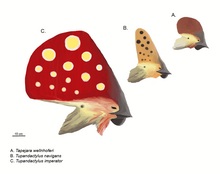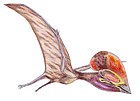|
Tapejara wellnhoferi
Tapejara (from a Tupi word meaning "the lord of the ways"[1]) is a genus of Brazilian pterosaur from the Cretaceous Period (Santana Formation, dating to about 127 to 112 million years ago). Tapejara crests consisted of a semicircular crest over the snout, and a bony prong which extended back behind the head. It was a small pterosaur, with a wingspan of approximately 1.23–1.3 metres (4.0–4.3 ft).[2] Species and classification The type species and only one currently recognized as valid by most researchers, is T. wellnhoferi. The specific name honors German paleontologist Peter Wellnhofer. Two larger species, originally named Tapejara imperator and Tapejara navigans, were later also placed in the genus Tapejara upon discovery. However, several studies have shown that T. imperator and T. navigans are significantly different from T. wellnhoferi and therefore were reclassified into new genera. The species T. imperator was given its own genus, Tupandactylus, by Alexander Kellner and Diogenes de Almeida Campos.[3] Unwin and Martill found that T. imperator and T. navigans belong in the same genus, and named them Ingridia imperator and I. navigans, respectively. This genus name honored Wellnhofer's late wife Ingrid.[4] Because Tupandactylus was named first, it retained priority over the name Ingridia. To complicate matters, both the name Tupandactylus and Ingridia used the former Tapejara imperator as their type species.[5] The scientists who described Tupandactylus did not name a Tupandactylus navigans (but instead suggested it was synonymous to Tupandactylus imperator), and Tapejara navigans was not formally reclassified as a distinct species of Tupandactylus until 2011.[6]  The cladogram below follows a phylogenetic analysis by Kellner, the describer of Tapejara, and colleagues in 2019. They recovered Tapejara within the Tapejarini (a tribe within the family Tapejaridae), sister taxon to three other genera: Europejara, Caiuajara, and Tupandactylus.[7]
PaleobiologyComparisons between the scleral rings of Tapejara and modern birds and reptiles suggest that it may have been cathemeral, active throughout the day at short intervals.[8] See alsoReferences
Information related to Tapejara wellnhoferi |
|||||||||||||||||||||||||||||||||||||||||||||||||||||||||||||||||||||||||||||||||||||||||













